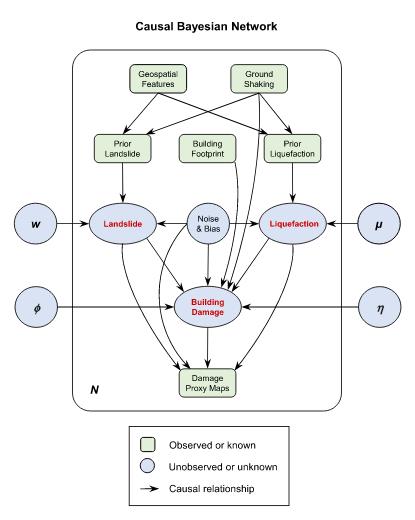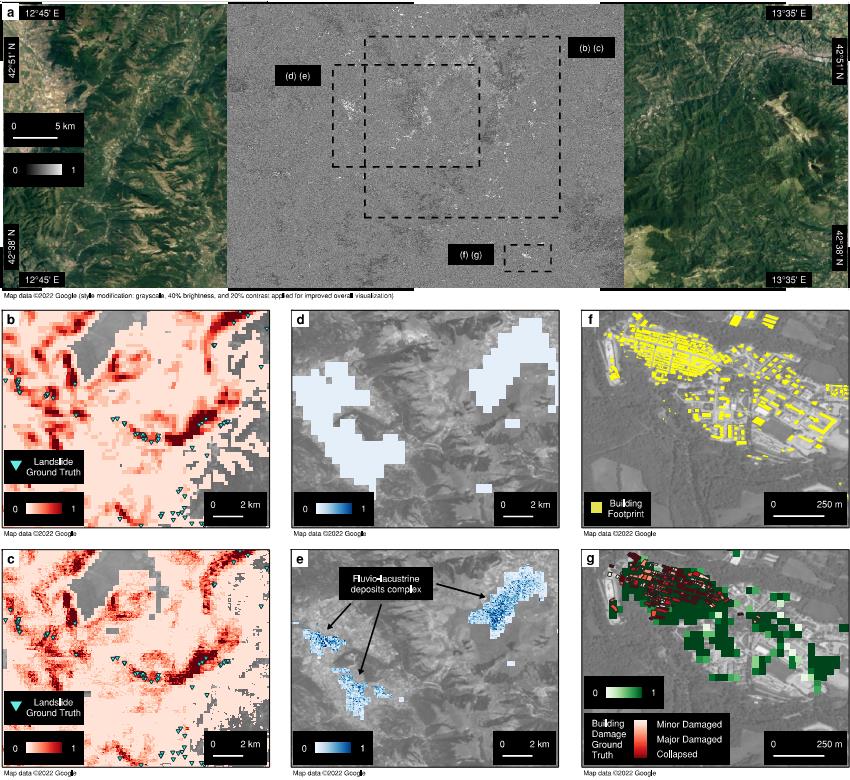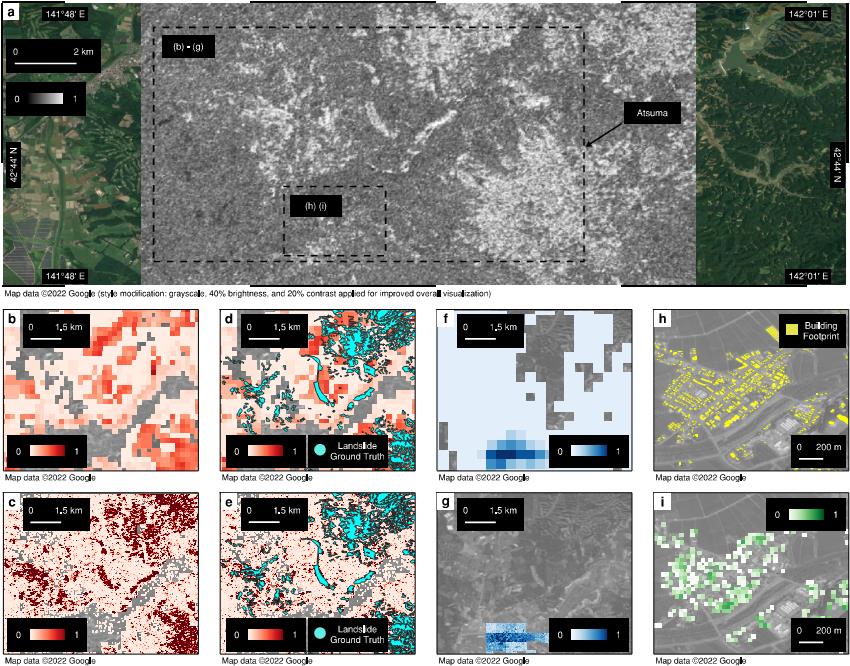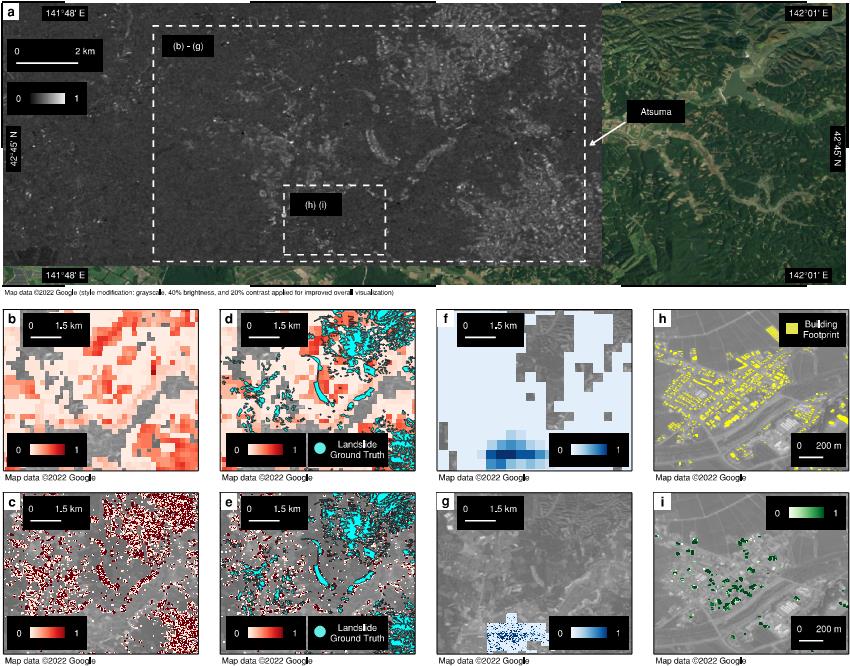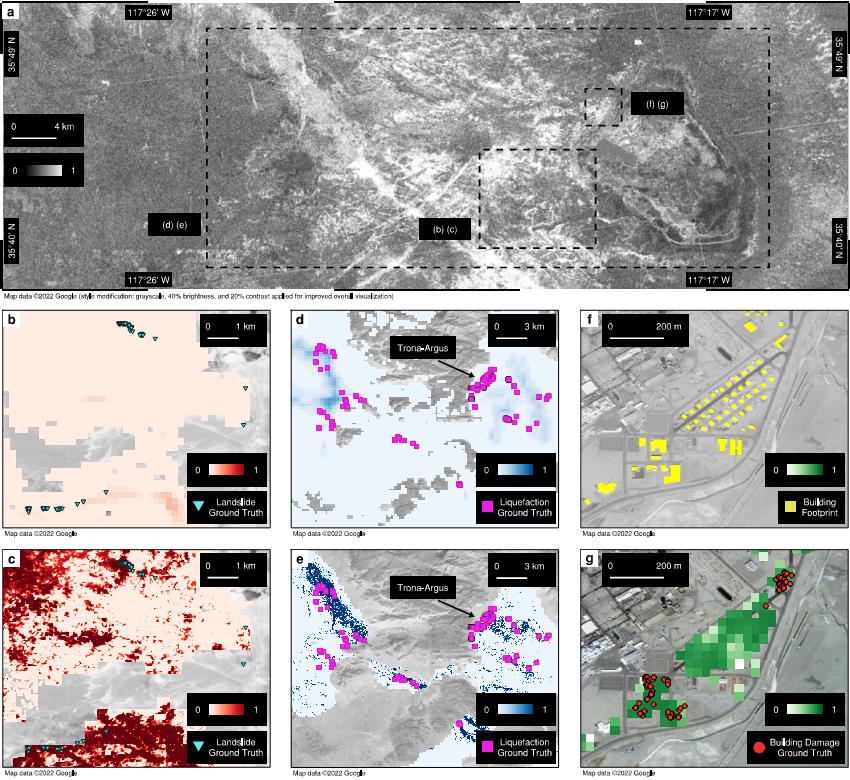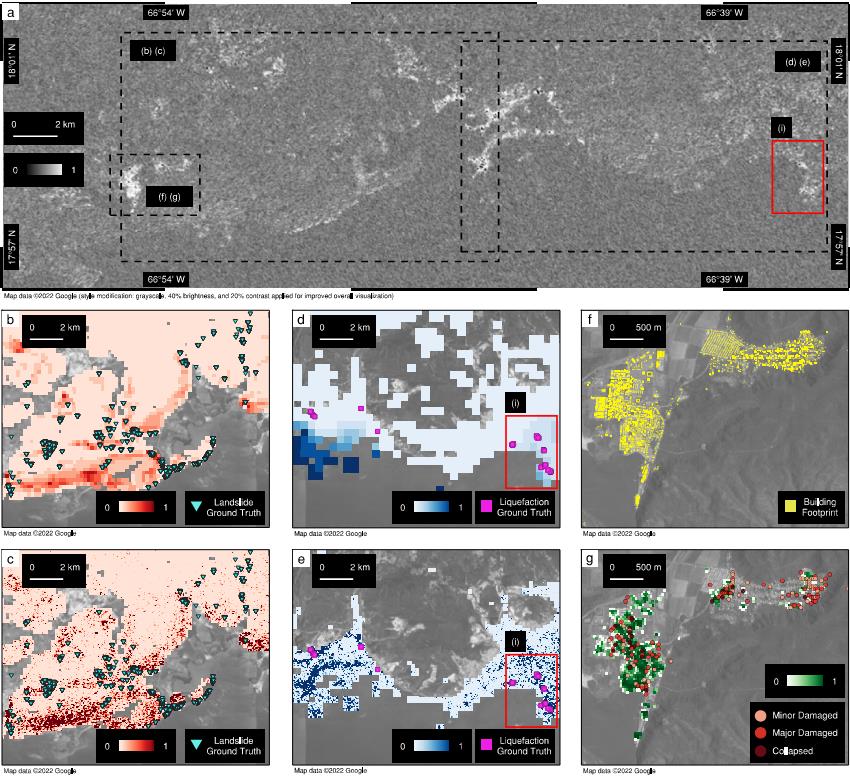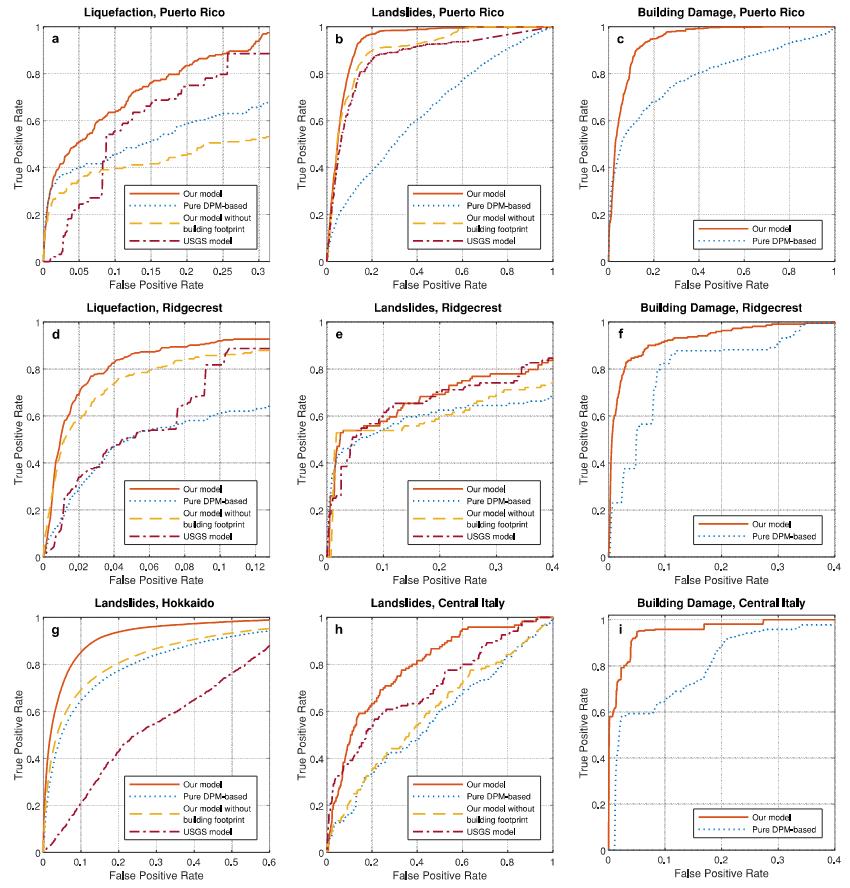Variational Causal Bayesian Inference for Seismic Multi-hazard and Impact Estimation from Satellite Images
This GitHub repository contains the code, data, and figures for the Nature Communications paper Seismic Multi-hazard and Impact Estimation via Causal Inference from Satellite Imagery. If you have any questions, please contact susu.xu@stonybrook.edu.
This code depends on MALTAB R2022a, QGIS 3.22.2-Białowieża, or any newer versions. The MATLAB Mapping Toolbox must also be installed to enable the data import and export of GeoTIFF files (*.tif).
Download and store the input raster TIF files for damage proxy map, building footprint, prior landslide model, and prior liquefaction model to local directory. Please make sure that they have consistent size and dimension. In most cases, prior models have much lower resolutions than damage proxy map, so it is necessary to discretize the prior estimations to make the map size the same as the damage proxy maps (though the resolution stays low). We studied the following four earthquake events:
- Earthquake Event
- 2016_central_italy, USGS Event Page
- 2018_hokkaido_japan_5m, USGS Event Page
- 2018_hokkaido_japan_30m, USGS Event Page, (same as the previous one but with different resolution)
- 2019_ridgecrest, USGS Event Page
- 2020_puerto_rico, USGS Event Page
We have made all the post-processed inputs and outputs available inside the data folder. Supplementary datasets are provided below if anyone would like to visualize the vector representation of building footprint and ground truth datasets. The MATLAB codes will need the TIF files only, which are results of the post-processing of supplementary datasets. Each earthquake event has the following datasets:
- Input Data
- PLS:
data/<event>/prior_models/<event>_prior_landslide_model.tif - PLF:
data/<event>/prior_models/<event>_prior_liquefaction_model.tif - BD:
data/<event>/building_footprint/<event>_building_footprint_rasterized.tif - DPM:
data/<event>/damage_proxy_map/<event>_damage_proxy_map.tif
- PLS:
- Output Data
- QLS:
data/<event>/posterior_models/<event>_posterior_landslide_model.tif - QLS:
data/<event>/posterior_models/<event>_posterior_liquefaction_model.tif - QBD:
data/<event>/building_damage_model/<event>_building_damage_model.tif
- QLS:
- Validation or Performance Assessment
- GTLS:
data/<event>/ground_truth/<event>_landslide_ground_truth_rasterized.tif - GTLF:
data/<event>/ground_truth/<event>_liquefaction_ground_truth_rasterized.tif - GTBD:
data/<event>/ground_truth/<event>_building_damage_ground_truth_rasterized.tif
- GTLS:
- Supplementary Datasets
- Building Footprint GIS Shapefile:
data/<event>/building_footprint/<event>_building_footprint.zip
- Building Footprint GIS Shapefile:
The main codes located under the directory of method.
updating.m is the main function to optimize the causal Bayesian inference. In the updating.m, "location" refers to the directory storing damage proxy map (DPM), building footprint (BD), prior landslide (PLS), and prior liquefaction (PLF). In updating.m:
-
prune_typerepresents the type of pruning the original causal graph to accelerate the computing. "double" refers to symmetric pruning where given a location, prune one node from LS and LF if the absolute difference between prior LS and LF is larger than a given threshold specified by sigma (which is often set as 0 or median of the difference). "single" refers to an asymmetric pruning where given a location, prune LF node if LS is larger than LF+sigma and prune LS if LF is larger than LS, or the opposite case. -
sigmarefers to pruning threshold to retain only one node from LS and LF in the locations where prior models are very sure that only one of the hazards exist. If you are confident with the prior model, you can set sigma as 0, otherwise we will recommend to try median or mean of the absolute differences.Events sigma2016 Central Italy earthquake zero 2018 Hokkaido earthquake median 2019 Ridgecrest earthquake median 2020 Puerto Rico earthquake zero -
lambdaandregu_typerefer to the regularization term.regu_type == 1refers to that the model will rely more on DPM,regu_type == 2refers to that the model will rely more on the prior model. lambda control the levels of regularization, higher means more strongly restricting the impacts of DPM (regu_type==2) or prior model(regu_type==1). We recommend to setup lambda as 0 if you do not have any prior understanding about the confidence level of DPM and prior models. -
rhois the learning rate for optimization,deltais the aceptable tolerance level for convergence.eps_0is a small number to get rid of negative entropy. -
Nqis the number of posterior probability iterations at each location in each epoch. We often set it as 10. -
SVI.mis the stochastic variational inference process which optimizes the posterior and weights. -
performance.mrefers to the evaluation metric, including true positive rate, false positive rate, ROC, DET, PR, and AUC calculation.
The results are automatically saved in the location specified by 'filename' in updating.m. final_QLS, final_QLF are the landslide, liquefaction estimation by our model, respectively. opt_QBD is the building damage (BD) estiamtion by our model. local is the finally updated pruning strategy, local = 1,3 represent only LS or LS+BD, local = 2,4 refer to only LF or LF+BD, local = 5 refers to LS+LF, local=6 refers to LS+LF+BD. If you are very sure about the mutual exclusive between LS and LF at some locations, you can incorporate that in the original pruning strategies (prune.m).
The system is built based on the causal graph depicting the physical interdependencies among different seismic hazards, impacts, and Damage Proxy Maps (DPMs).
We tested the performance of our system on multiple earthquake events, including the 2016 Central Italy earthquake, 2018 Hokkaido earthquake, 2019 Ridgecrest earthquake, and 2020 Puerto Rico earthquake. We here show a map visualization showing the comparison between our prediction results and existing USGS models.
Using the ROC curve, we show that our model significantly improves the current landslide and liquefaction models.
├───code
│ ├───method
│ │ df.m
│ │ f.m
│ │ Loss.m
│ │ parder.m
│ │ pruning.m
│ │ SVI.m
│ │ Tfxn.m
│ │ updating.m
│ │
│ └───performance
│ binaryerror.m
│ cel.m
│ performance.m
│ rocdetpr.m
│
├───data
│ ├───2016_central_italy
│ │ ├───building_damage_model
│ │ │ 2016_central_italy_building_damage_model.tif
│ │ │
│ │ ├───building_footprint
│ │ │ 2016_central_italy_building_footprint.zip
│ │ │ 2016_central_italy_building_footprint_rasterized.tif
│ │ │
│ │ ├───ground_truth
│ │ │ 2016_central_italy_building_damage_ground_truth_rasterized.tif
│ │ │ 2016_central_italy_landslide_ground_truth_rasterized.tif
│ │ │
│ │ ├───posterior_models
│ │ │ 2016_central_italy_posterior_landslide_model.tif
│ │ │ 2016_central_italy_posterior_liquefaction_model.tif
│ │ │
│ │ └───prior_models
│ │ 2016_central_italy_prior_landslide_model.tif
│ │ 2016_central_italy_prior_liquefaction_model.tif
│ │
│ ├───2018_hokkaido_japan_30m
│ │ ├───building_damage_model
│ │ │ 2018_hokkaido_japan_30m_building_damage_model.tif
│ │ │
│ │ ├───building_footprint
│ │ │ 2018_hokkaido_japan_30m_building_footprint.zip
│ │ │ 2018_hokkaido_japan_30m_building_footprint_rasterized.tif
│ │ │
│ │ ├───ground_truth
│ │ │ 2018_hokkaido_japan_30m_landslide_ground_truth_rasterized.tif
│ │ │
│ │ ├───posterior_models
│ │ │ 2018_hokkaido_japan_30m_posterior_landslide_model.tif
│ │ │ 2018_hokkaido_japan_30m_posterior_liquefaction_model.tif
│ │ │
│ │ └───prior_models
│ │ 2018_hokkaido_japan_30m_prior_landslide_model.tif
│ │ 2018_hokkaido_japan_30m_prior_liquefaction_model.tif
│ │
│ ├───2018_hokkaido_japan_5m
│ │ ├───building_damage_model
│ │ │ 2018_hokkaido_japan_5m_building_damage_model.tif
│ │ │
│ │ ├───building_footprint
│ │ │ 2018_hokkaido_japan_5m_building_footprint.zip
│ │ │ 2018_hokkaido_japan_5m_building_footprint_rasterized.tif
│ │ │
│ │ ├───ground_truth
│ │ │ 2018_hokkaido_japan_5m_landslide_ground_truth_rasterized.tif
│ │ │
│ │ ├───posterior_models
│ │ │ 2018_hokkaido_japan_5m_posterior_landslide_model.tif
│ │ │ 2018_hokkaido_japan_5m_posterior_liquefaction_model.tif
│ │ │
│ │ └───prior_models
│ │ 2018_hokkaido_japan_5m_prior_landslide_model.tif
│ │ 2018_hokkaido_japan_5m_prior_liquefaction_model.tif
│ │
│ ├───2019_ridgecrest
│ │ ├───building_damage_model
│ │ │ 2019_ridgecrest_building_damage_model.tif
│ │ │
│ │ ├───building_footprint
│ │ │ 2019_ridgecrest_building_footprint.zip
│ │ │ 2019_ridgecrest_building_footprint_rasterized.tif
│ │ │
│ │ ├───ground_truth
│ │ │ 2019_ridgecrest_building_damage_ground_truth_rasterized.tif
│ │ │ 2019_ridgecrest_landslide_ground_truth_rasterized.tif
│ │ │ 2019_ridgecrest_liquefaction_ground_truth_rasterized.tif
│ │ │
│ │ ├───posterior_models
│ │ │ 2019_ridgecrest_posterior_landslide_model.tif
│ │ │ 2019_ridgecrest_posterior_liquefaction_model.tif
│ │ │
│ │ └───prior_models
│ │ 2019_ridgecrest_prior_landslide_model.tif
│ │ 2019_ridgecrest_prior_liquefaction_model.tif
│ │
│ └───2020_puerto_rico
│ ├───building_damage_model
│ │ 2020_puerto_rico_building_damage_model.tif
│ │
│ ├───building_footprint
│ │ 2020_puerto_rico_building_footprint.zip
│ │ 2020_puerto_rico_building_footprint_rasterized.tif
│ │
│ ├───damage_proxy_map
│ │ 2020_puerto_rico_damage_proxy_map.tif
│ │
│ ├───ground_truth
│ │ 2020_puerto_rico_building_damage_ground_truth_rasterized.tif
│ │ 2020_puerto_rico_landslide_ground_truth_rasterized.tif
│ │ 2020_puerto_rico_liquefaction_ground_truth_rasterized.tif
│ │
│ ├───posterior_models
│ │ 2020_puerto_rico_posterior_landslide_model.tif
│ │ 2020_puerto_rico_posterior_liquefaction_model.tif
│ │
│ └───prior_models
│ 2020_puerto_rico_prior_landslide_model.tif
│ 2020_puerto_rico_prior_liquefaction_model.tif
│
└───figures
├───fig1
│ fig1_causal_graph_editable.pptx
│ fig1_causal_graph_flattened.jpg
│ fig1_causal_graph_flattened.pdf
│
├───fig2
│ │ fig2_full_auc_results_editable.pdf
│ │ fig2_full_auc_results_flattened.jpg
│ │ fig2_full_auc_results_flattened.pdf
│ │
│ └───subplots
│ fig2a.pdf
│ fig2b.pdf
│ fig2c.pdf
│ fig2d.pdf
│ fig2e.pdf
│ fig2f.pdf
│ fig2g.pdf
│ fig2h.pdf
│ fig2i.pdf
│
├───fig3
│ fig3_puertorico_editable.pdf
│ fig3_puertorico_flattened.jpg
│ fig3_puertorico_flattened.pdf
│
├───fig4
│ fig4_japan30m_editable.pdf
│ fig4_japan30m_flattened.jpg
│ fig4_japan30m_flattened.pdf
│
├───fig5
│ │ fig5_editable.pdf
│ │ fig5_flattened.jpg
│ │ fig5_flattened.pdf
│ │
│ └───subplots
│ fig5a_fig5b_weights_editable.pdf
│ fig5a_fig5b_weights_editable.pptx
│ fig5c.pdf
│ fig5d.pdf
│
├───supplementaryfig1
│ supplementaryfig1_centralitaly_editable.pdf
│ supplementaryfig1_centralitaly_flattened.jpg
│ supplementaryfig1_centralitaly_flattened.pdf
│
├───supplementaryfig2
│ supplementaryfig2_ridgecrest_editable.pdf
│ supplementaryfig2_ridgecrest_flattened.jpg
│ supplementaryfig2_ridgecrest_flattened.pdf
│
├───supplementaryfig3
│ supplementaryfig3_japan5m_editable.pdf
│ supplementaryfig3_japan5m_flattened.jpg
│ supplementaryfig3_japan5m_flattened.pdf
│
├───supplementaryfig4
│ │ supplementaryfig4_editable.pdf
│ │ supplementaryfig4_flattened.jpg
│ │ supplementaryfig4_flattened.pdf
│ │
│ └───subplots
│ supplementaryfig4a_fig4b_weights_editable.pdf
│ supplementaryfig4a_fig4b_weights_editable.pptx
│ supplementaryfig4c.pdf
│ supplementaryfig4d.pdf
│
└───supplementaryfig5
│ supplementaryfig5_editable.pdf
│ supplementaryfig5_flattened.jpg
│ supplementaryfig5_flattened.pdf
│
└───subplots
supplementaryfig5a.pdf
supplementaryfig5b.pdf
Any use of trade, firm, or product names is for descriptive purposes only and does not imply endorsement by the U.S. Government. S.X. was supported by USGS Earthquake Hazards Program G22AP00032 and Research Foundations at Stony Brook University. J.D. was supported by the Stanford Knight-Hennessy Scholars Program. J.D. was affiliated with the Department of Civil and Environmental Engineering at Stanford University at the time of work and is currently affiliated with the UKRI CDT in the Application of Artificial Intelligence to the study of Environmental Risks (AI4ER) at the University of Cambridge. The authors would like to thank Dr. Sang-Ho Yun, Dr. Eric Fielding, and NASA ARIA team for providing their Damage Proxy Maps products. The authors would like to thank Dr. Kate Allstadt, Dr. Eric Thompson, Dr. Kishor Jaiswal, Dr. Sabine Loos, and Davis Engler from USGS for providing their prior geospatial models and valuable suggestions.
Feel free to use our recommended BibTex-formatted entry below.
@misc{xus2022,
author = {Susu Xu, Joshua Dimasaka},
title = {Seismic Multi-hazard and Impact Estimation via Causal Inference from Satellite Imagery},
year = {2022},
publisher = {GitHub},
journal = {GitHub repository},
howpublished = {\url{https://doi.org/10.5281/zenodo.7319726}},
commit = {4f57d6a0e4c030202a07a60bc1bb1ed1544bf679}
}

